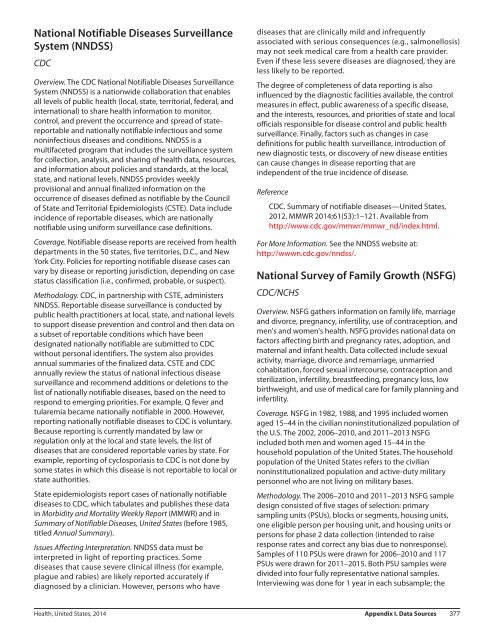hus14
hus14
hus14
Create successful ePaper yourself
Turn your PDF publications into a flip-book with our unique Google optimized e-Paper software.
National Notifiable Diseases Surveillance<br />
System (NNDSS)<br />
CDC<br />
Overview. The CDC National Notifiable Diseases Surveillance<br />
System (NNDSS) is a nationwide collaboration that enables<br />
all levels of public health (local, state, territorial, federal, and<br />
international) to share health information to monitor,<br />
control, and prevent the occurrence and spread of statereportable<br />
and nationally notifiable infectious and some<br />
noninfectious diseases and conditions. NNDSS is a<br />
multifaceted program that includes the surveillance system<br />
for collection, analysis, and sharing of health data, resources,<br />
and information about policies and standards, at the local,<br />
state, and national levels. NNDSS provides weekly<br />
provisional and annual finalized information on the<br />
occurrence of diseases defined as notifiable by the Council<br />
of State and Territorial Epidemiologists (CSTE). Data include<br />
incidence of reportable diseases, which are nationally<br />
notifiable using uniform surveillance case definitions.<br />
Coverage. Notifiable disease reports are received from health<br />
departments in the 50 states, five territories, D.C., and New<br />
York City. Policies for reporting notifiable disease cases can<br />
vary by disease or reporting jurisdiction, depending on case<br />
status classification (i.e., confirmed, probable, or suspect).<br />
Methodology. CDC, in partnership with CSTE, administers<br />
NNDSS. Reportable disease surveillance is conducted by<br />
public health practitioners at local, state, and national levels<br />
to support disease prevention and control and then data on<br />
a subset of reportable conditions which have been<br />
designated nationally notifiable are submitted to CDC<br />
without personal identifiers. The system also provides<br />
annual summaries of the finalized data. CSTE and CDC<br />
annually review the status of national infectious disease<br />
surveillance and recommend additions or deletions to the<br />
list of nationally notifiable diseases, based on the need to<br />
respond to emerging priorities. For example, Q fever and<br />
tularemia became nationally notifiable in 2000. However,<br />
reporting nationally notifiable diseases to CDC is voluntary.<br />
Because reporting is currently mandated by law or<br />
regulation only at the local and state levels, the list of<br />
diseases that are considered reportable varies by state. For<br />
example, reporting of cyclosporiasis to CDC is not done by<br />
some states in which this disease is not reportable to local or<br />
state authorities.<br />
State epidemiologists report cases of nationally notifiable<br />
diseases to CDC, which tabulates and publishes these data<br />
in Morbidity and Mortality Weekly Report (MMWR) and in<br />
Summary of Notifiable Diseases, United States (before 1985,<br />
titled Annual Summary).<br />
Issues Affecting Interpretation. NNDSS data must be<br />
interpreted in light of reporting practices. Some<br />
diseases that cause severe clinical illness (for example,<br />
plague and rabies) are likely reported accurately if<br />
diagnosed by a clinician. However, persons who have<br />
diseases that are clinically mild and infrequently<br />
associated with serious consequences (e.g., salmonellosis)<br />
may not seek medical care from a health care provider.<br />
Even if these less severe diseases are diagnosed, they are<br />
less likely to be reported.<br />
The degree of completeness of data reporting is also<br />
influenced by the diagnostic facilities available, the control<br />
measures in effect, public awareness of a specific disease,<br />
and the interests, resources, and priorities of state and local<br />
officials responsible for disease control and public health<br />
surveillance. Finally, factors such as changes in case<br />
definitions for public health surveillance, introduction of<br />
new diagnostic tests, or discovery of new disease entities<br />
can cause changes in disease reporting that are<br />
independent of the true incidence of disease.<br />
Reference<br />
CDC. Summary of notifiable diseases—United States,<br />
2012. MMWR 2014;61(53):1–121. Available from<br />
http://www.cdc.gov/mmwr/mmwr_nd/index.html.<br />
For More Information. See the NNDSS website at:<br />
http://wwwn.cdc.gov/nndss/.<br />
National Survey of Family Growth (NSFG)<br />
CDC/NCHS<br />
Overview. NSFG gathers information on family life, marriage<br />
and divorce, pregnancy, infertility, use of contraception, and<br />
men's and women's health. NSFG provides national data on<br />
factors affecting birth and pregnancy rates, adoption, and<br />
maternal and infant health. Data collected include sexual<br />
activity, marriage, divorce and remarriage, unmarried<br />
cohabitation, forced sexual intercourse, contraception and<br />
sterilization, infertility, breastfeeding, pregnancy loss, low<br />
birthweight, and use of medical care for family planning and<br />
infertility.<br />
Coverage. NSFG in 1982, 1988, and 1995 included women<br />
aged 15–44 in the civilian noninstitutionalized population of<br />
the U.S. The 2002, 2006–2010, and 2011–2013 NSFG<br />
included both men and women aged 15–44 in the<br />
household population of the United States. The household<br />
population of the United States refers to the civilian<br />
noninstitutionalized population and active-duty military<br />
personnel who are not living on military bases.<br />
Methodology. The 2006–2010 and 2011–2013 NSFG sample<br />
design consisted of five stages of selection: primary<br />
sampling units (PSUs), blocks or segments, housing units,<br />
one eligible person per housing unit, and housing units or<br />
persons for phase 2 data collection (intended to raise<br />
response rates and correct any bias due to nonresponse).<br />
Samples of 110 PSUs were drawn for 2006–2010 and 117<br />
PSUs were drawn for 2011–2015. Both PSU samples were<br />
divided into four fully representative national samples.<br />
Interviewing was done for 1 year in each subsample; the<br />
Health, United States, 2014 Appendix I. Data Sources 377


